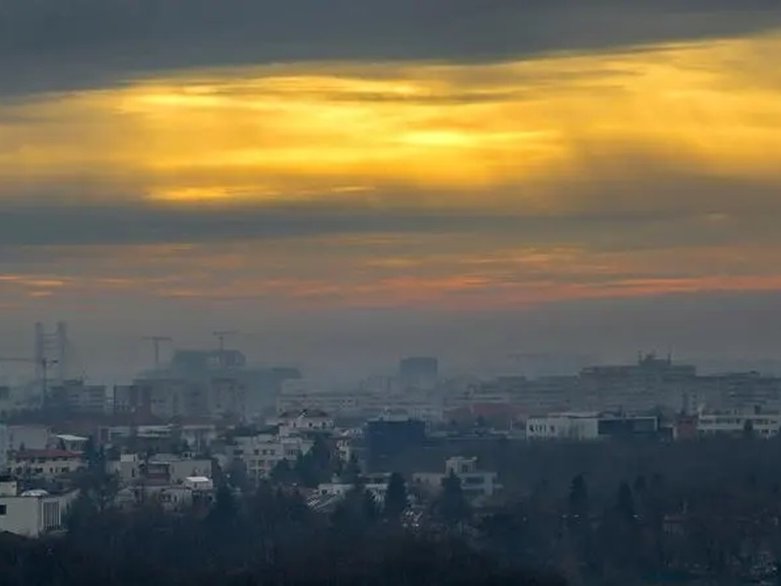Air pollution in November: how toxic Bucharest becomes once the heating season begins

By Bucharest Team
- Articles
With the arrival of cold weather, Bucharest slips under an invisible blanket of pollutants. The smell of smoke and the heavy air are not seasonal impressions, but direct consequences of higher thermal energy consumption, congested traffic, and atmospheric conditions that prevent toxic substances from dispersing.
When the air profile changes
November marks the start of the season when the city’s air becomes significantly dirtier. Levels of fine particles — PM2.5 and PM10 — rise as individual heating systems and the central district heating network are switched on.
PM2.5 refers to microscopic particles of dust, soot, and chemical compounds smaller than 2.5 microns — small enough to penetrate deep into the lungs and even enter the bloodstream.
PM10 represents larger particles (up to 10 microns), originating from dust, vehicle emissions, fuel combustion, or industrial activity. Both are dangerous through constant exposure, not just on days with high readings.
On cold, windless nights, pollution levels can climb up to ten times above legal limits. Beyond the numbers, that means dense air and real physical discomfort felt by residents across the city — particularly in crowded, peripheral districts.
Main sources of pollution in November
Heating systems. Once the heating season begins, the burning of gas, wood, or other fuels produces large amounts of suspended particles, nitrogen oxides, and other toxic gases. In several residential areas, solid fuels are still commonly used, intensifying the problem.
Traffic. Bucharest continues to have one of the densest traffic flows in Eastern Europe. Vehicles emit nitrogen dioxide, fine particles, and hydrocarbons which, during cold months, remain trapped near ground level. Frequent congestion, idling engines, and the lack of green buffers capable of filtering the air all worsen the situation.
Weather conditions. Low temperatures, lack of wind, and overcast skies create ideal conditions for pollution build-up. The phenomenon of thermal inversion — increasingly frequent in November — traps cold air beneath a warmer layer, sealing in pollution close to the ground.
Data that outline the reality
Road traffic accounts for roughly 60% of Bucharest’s air pollution. The rest comes from heating systems, construction sites, and uncontrolled waste burning.
Independent monitoring networks show a clear rise in PM2.5 concentrations during autumn — from “moderate” summer levels to consistently high ones in November. Experts describe the cold season as “aggressively polluted,” with peaks between October and March.
On many autumn nights, sensors in neighborhoods like Drumul Taberei, Rahova, or Colentina record levels exceeding health safety thresholds.
Health effects
Prolonged exposure to fine particles and nitrogen oxides is far from abstract. Air pollution is directly linked to higher rates of respiratory and cardiovascular disease, and even developmental disorders in children.
Medical organizations warn that the effects are cumulative — you don’t feel them immediately, but every day spent breathing polluted air chips away at the body’s resilience.
The social and economic cost of pollution in Bucharest is immense: productivity losses, medical leaves, expensive treatments, and an overall decline in quality of life.
What’s missing from the city’s response
The municipality has a Plan for Maintaining Air Quality (2018–2022), but its implementation has been fragmented and slow. The official monitoring system remains incomplete, with few stations and outdated reports.
Although individual heating systems are recognized as major pollution sources, there is no public inventory of fuel types used or of equipment efficiency.
Measures such as taxing old vehicles, expanding electric transport, or reintroducing urban green belts are delayed or only partially implemented.
Conclusion
November exposes Bucharest’s structural weaknesses: outdated infrastructure, poor coordination between institutions, and excessive reliance on individual heating. As the air becomes increasingly difficult to breathe, the city remains trapped in the same vicious cycle — each winter bringing the same problems, without a coherent long-term strategy to reduce emissions.
Also recommended The city that breathes heavier: autumn pollution and waste burning around Bucharest
Photo: Bogdan Anghel / Dreamstime.com






























